Complete Solutions to Exercises of chapter CIRCULAR MOTION of Class 11 book with complete answers and questions
| Class 11 | PHYSICS |
| Chapter | CIRCULAR MOTION |
| HC VERMA | Exercises |
| Number Of Questions | 30 |
| Academic Year | 2023-24 |
Find the accelerationof the moon with respect to the eath from the following data, Distance between the earth and the moon `=3.85xx10^5` km and the time taken by the moon to complete one revolution around the earth `=27.3days
View SolutionFind the acceleration of a particle placed on the surface of the earth at the equator due to earth's rotation. The diameter of earth =12800 km and it takes 24 hour for the earth to complete one revolution about its axis.
View SolutionA particle moves in circle of radius 1.0 cm at a speed given by v=2.0 t where v is in cm/s and t in seconeds. A. find the radia accelerationof the particle at t=1 s. b. Findthe tangential acceleration at t=1s. c.Find the magnitude of the aceleration at t=1s.
View SolutionA scooter weighing 150 g together with its rider moving at 36 km/hr is to take a turn of radius 30 m. What horizontal force on the scooter is needed to make the turn possible?
View SolutionA scooter weighing 150 kg together with its rider moving at 36 km/hr is to take a turn of radius 30 m. What horizontal force on the scooter is needed to make the turn possible?If the horizontal force needed for the turn in the previous problem is to be supplied by the normal force by the road what should be the proper angle of banking?
View SolutionA park has a radis of 10 m. If a vehicle goes round it at an averge speed of 18 km/hr, what shoud be the proper angle of banking?
View SolutionIf the road of the previous problem is horizontal (no banking), what should be the minimum friction coefficeint so that a scooter going at 18 km/hr does not skid?
View SolutionA circular road of radius 50 m has the angel of banking equal to `30^0`. At what speed should a vehicle go on this road so that the friction is not used?
View SolutionIn the Bohr model of hydrogen atom, the electron is treated as a particle going in a circle with the centre at the proton. The proton itself is assumed to be fixed in an inertial frame. The centripetal force is provided by the Coloumb attraction. In the ground state, the electron goes round the proton in a circle of radius `5.3xx10^-11m`. Find the speed of the electron in the ground state. Mass of the electron `=9.1xx10^-31 kg ` and charge of the electron `= 1.6xx10^-19C`.
View SolutionA stone is fastened to one end of a string and is whirled in a verticla circle of radius R. Find the minimum speed the stone can have at the highest point of the circle.
View SolutionA ceiling fan has a diameter (of the circle through the outer edges of the three blades) of 120 cm and rpm 1500 at full speed.Consider a particle of mass 1 g sticking at the outer end of a blade. How much force does it experience when the fan runs at full speed? who exerts this force on the particle? How much force does the particle exert on the blade along its surface?
View SolutionAs mosquito is sitting on an L.P. record disc rotating on a trun tabel at `33 1/3` revolutions per minute. The distance of the mosquito from the centre of the turn table is 10 cm. Show that the friction coefficient between the record and the mosquito is greater than `pi^2/81`. Take `g=10m/s^2`
View SolutionA simple pendulum is suspended from the ceiling of a car taking a turn of radius 10 m at a speed of 36 km/h. Find the angle made by the string of the pendulum with the vertical if this angle does not change during the turn. Take `g=10 m/s^2`.
View SolutionThe bob of a simple pendulum of length 1 m has mass 100 g and a speed of 1.4 m/s at the lowest point in its path. Find the tension in the stirng at this instant.
View SolutionSuppose the bob of the previous problem has a speed of 1.4 m/s when the string makes an angle of 0.20 radian with the vertical. Find the tension at this instant. You can use `costheta=1-theta^2/2 and sintheta=theta` for small theta`.
View SolutionSuppose the amplitude of a simple pendulum having a bob of mass m is `theta_0`. Find the tension in the string when the bob is at its extreme position.
View SolutionA person stands on a spring balance at the equator. a.By what fraction is the balance reading less than his true weight? b.If the speed of earth's rotation is increased by such an amount that the balance reading is half the true weight, what will be the lenght of the day in this case?
View SolutionA turn of radius 20 m is banked for the vehicles going at a speed of 36km/h. If the coefficient of static friction between the road and the tyre is 0.4, what are the possible speeds of a vehicle so that it neither slips down nor skids up?
View SolutionA motorcycle has to move with a consatnt speed on an overbridge which is in the form of as circular arc of radius R and has a total length L. Suppose the motorcycle starts from the highest point. a. what can its maximum velocity be for which the contact with the road is not broken at the highest point? b. If the motorcycle goes at speed `1/sqrt2` times the maximum found in part a. where will it lose the contact with the road? c. What maximum uniform speed can it maintain on the bridge if it does not lose contact anywhere on the bridge?
View SolutionA car starts rest, on a horizontal circular road of radius R, the tangential acceleration of the car is a. The friction coefficient between the road and the tyre is `mu` Find the speed at which car will skid and also find the distance after travelling it skids.
View SolutionA block of mass `m` is kept on a horizontal ruler . The friction coefficient between the ruler and the block is `mu` . The ruler is fixed at one end the block is at a distance L from the fixed end . The ruler is rotated about the fixed end in the horizontal plane through the fixed end
a. What can the maximum angular speed be for which the block does not slip?
b. If the angular speed of the ruler is uniform increase from zero at an angular acceleration a at angular speed will the block slip?
View SolutionA track consists of two circular pars ABC and CDE of equal radius 100 m and joined smoothly as shown in figure.Each part subtends a right angle at its centre. A cycle weighing 100 kg together with rider travels at a constant speed of 18 km/h on the track. A. Find the normal contact force by the road on the cycle when it is at B and at D. b.Find the force of friction exerted by the track on the tyres when the cycle is at B,C and D. c. Find the normal force between the road and the cycle just before and just after the cycle crosses C. d. What should be the minimum friction coefficient between the road and the tyre, which will ensure that the cyclist can move with constant speed? Take `g=10 m/s^2`
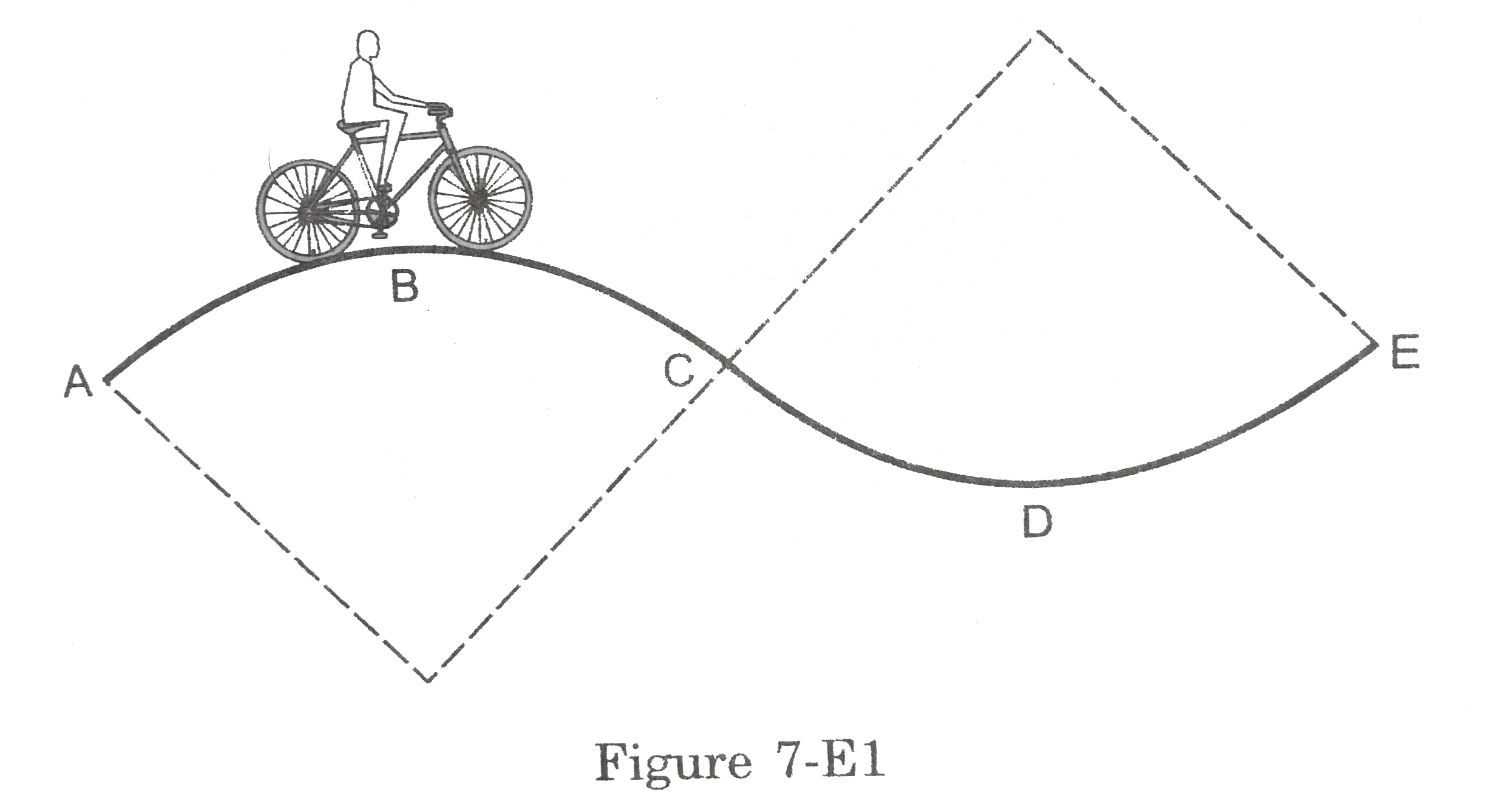
View SolutionIn a children's park a heavy rod is pivoted at the centre and is made to rotate about the pivot so that the rod always remains horizontal. Two kids hold the rod near the ends and thus rotate with the rod figure. Let the mas of each kid be 15 kg, the distance between the points of the rod where the two kids hold it be 3.0 m and suppose that the rod rotates at the rate of 20 revolutions per minute. Find the force of friction exerted by the rod on one of the kids.
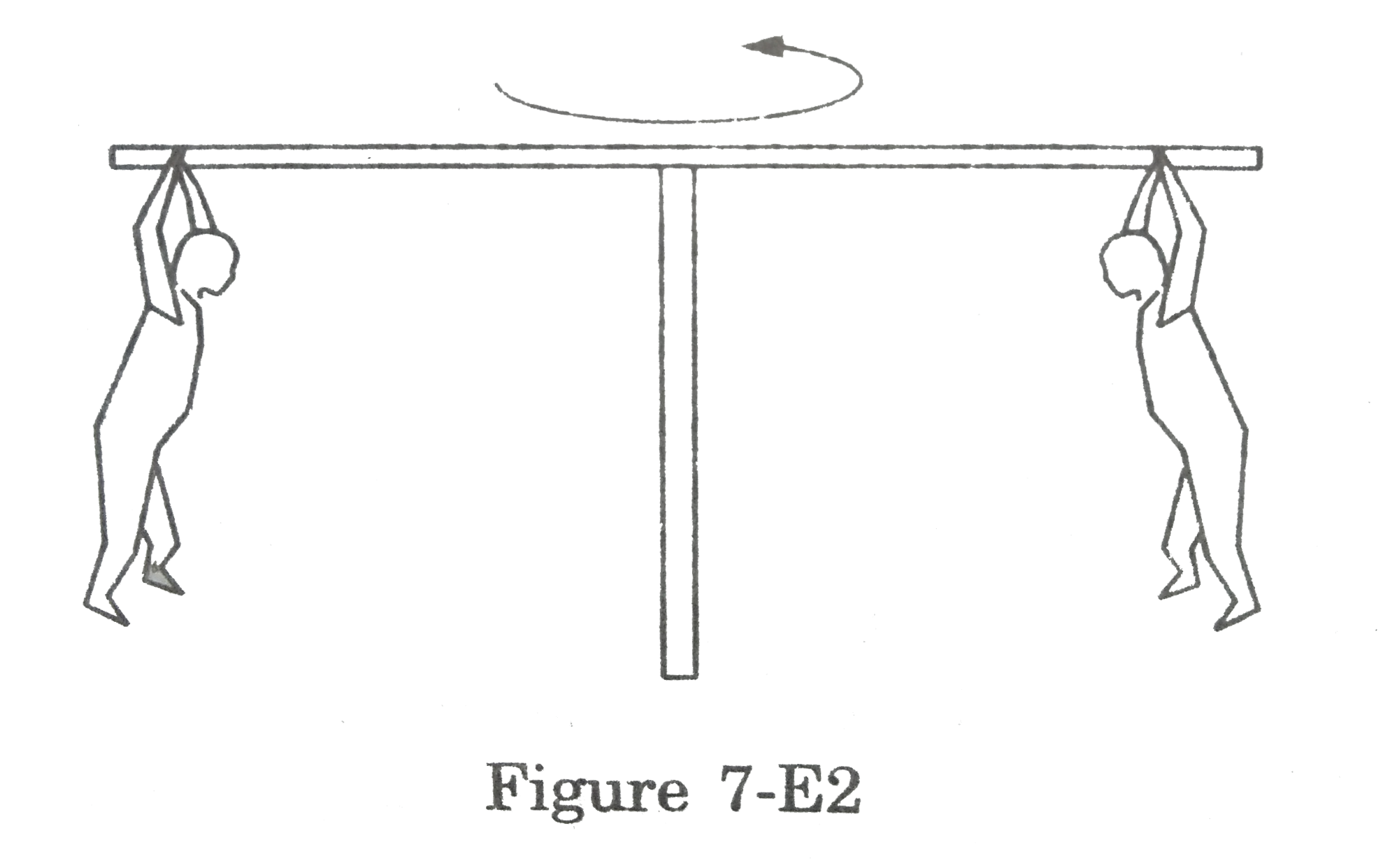
View SolutionA hemispherical bowl of radius R is rotated about its axis of symmetry which is kept vertical.A small block is kept in the bowl at a position where the radius makes an angle `theta` with the vertical. The block rotates with the bowl without any slipping. The friction coefficient between the block and the bowl surface is `mu`. Find the range of the angular speed for which the block will not slip.
View SolutionA particle is projected with a speed u at angle `theta` with the horizontal. Consider a small part of its path ner the highest position and take it approximately to be a circular arc. What is the rdius of this circle? This radius is called the adius of curvature of the curve at the point.
View SolutionWhat is the radius of curvature of the parabola traced out by the projectile in which a particle is projected with a speed u at an angle `theta` with the horizontal, at a point where the velocity of particle makes an angle `theta//2` with the horizontal.
View SolutionA block is mass m moves on as horizontal circle against the wall of a cylindrical room of radius R. The floor of the room on which the block moves is smooth but the friction coefficient between the wall and the block is `mu`. The block is given an initial speed `v_0`. As a function of the speed v write a. the normal force by the wall on the block. b. the frictional force by the wall and c. the tangential acceleration of the block. d. Integrate the tangential acceleration `((dv)/(dt)=v(dv)/(ds))` to obtain the speed of the block after one revoluton.
View SolutionA table with smooth horizontal surface is fixed in a cabin that rotates with a uniform angular velocity `omega` in a circular pathof radius R. A smooth groove AB of length `L(ltltR)` is made on the surface of the table. The groove makes an angle` theta` with the radius OA of the circle in which the cabin rotates. A small particle is kept at the point A in the groove and is released to move along AB. Find the time taken by tehparticle to reach the point B.
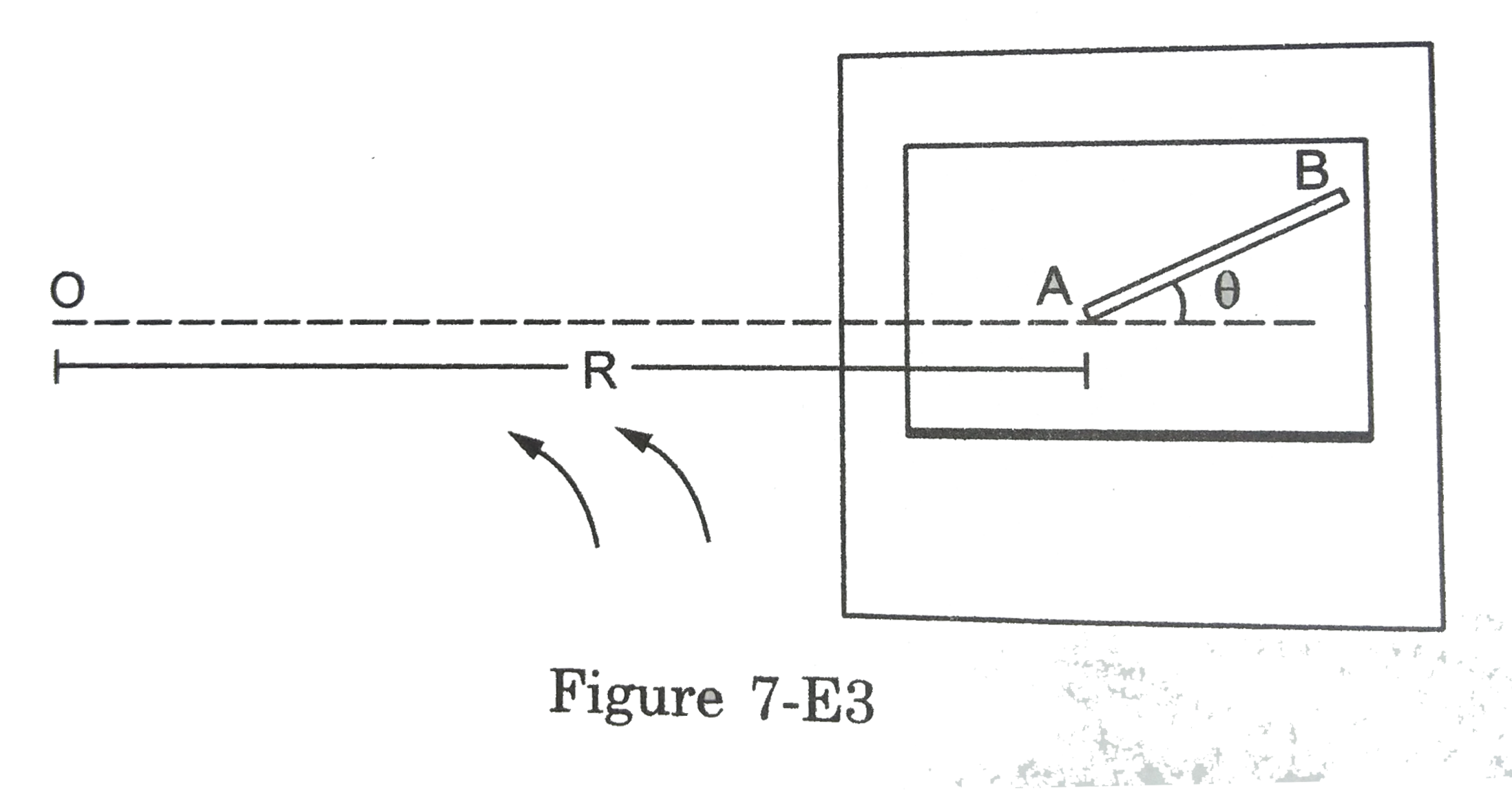
View SolutionA car moving at a speed of 36 km/hr is taking a turn on a circular road of radius 50 m. A small wooden plate is kept on the seat with its plane perpendicular to the radius of the circular road figure. A small bock of mass 100 g is kept on the seat which rests against the plate. The friction coefficient between the block and the plate is `mu=0.58.` a. Find the normal contact force exerted by the plate on the block. b. The plate is slowly turned so that the angle between the normal to the plate and the radius of the road slowly increases Find the angle at which the block will just start sliding on the plate.
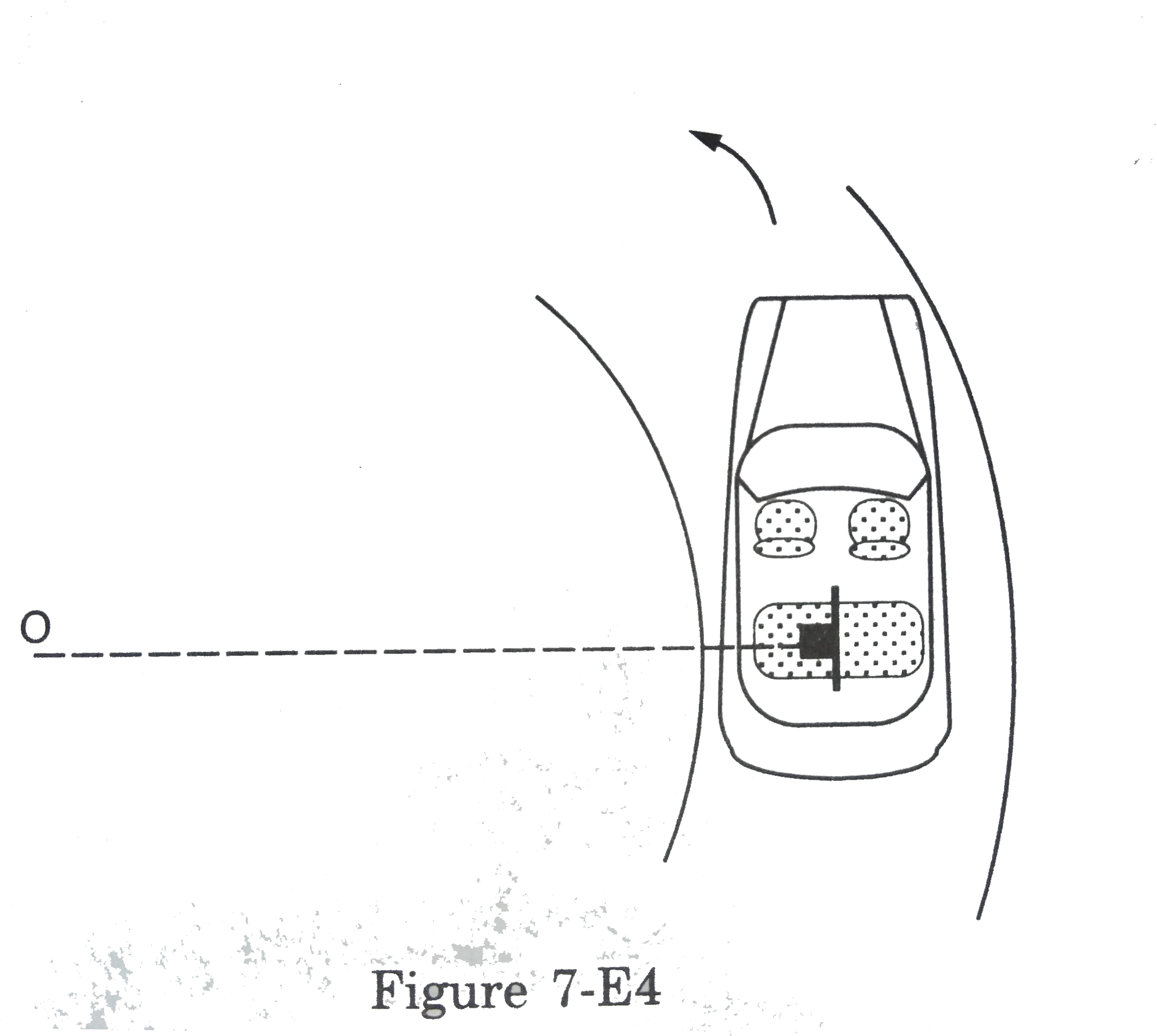
View SolutionA table with smooth horizontal surface is placed in a cabin which moves in a circle of a large radius R Figure. A smooth pulley of small radius is fastened to the table. Two masses m and 2m placed on te tableare connected through a string going over the pulley. Initially the masses are held by a personwith the strings aslong teh outward radius and then the system is released from rest (with respect to the cabin). Find the magnitude of the initial acceleration of the mases as seen from the cabin and the tension in the starting.
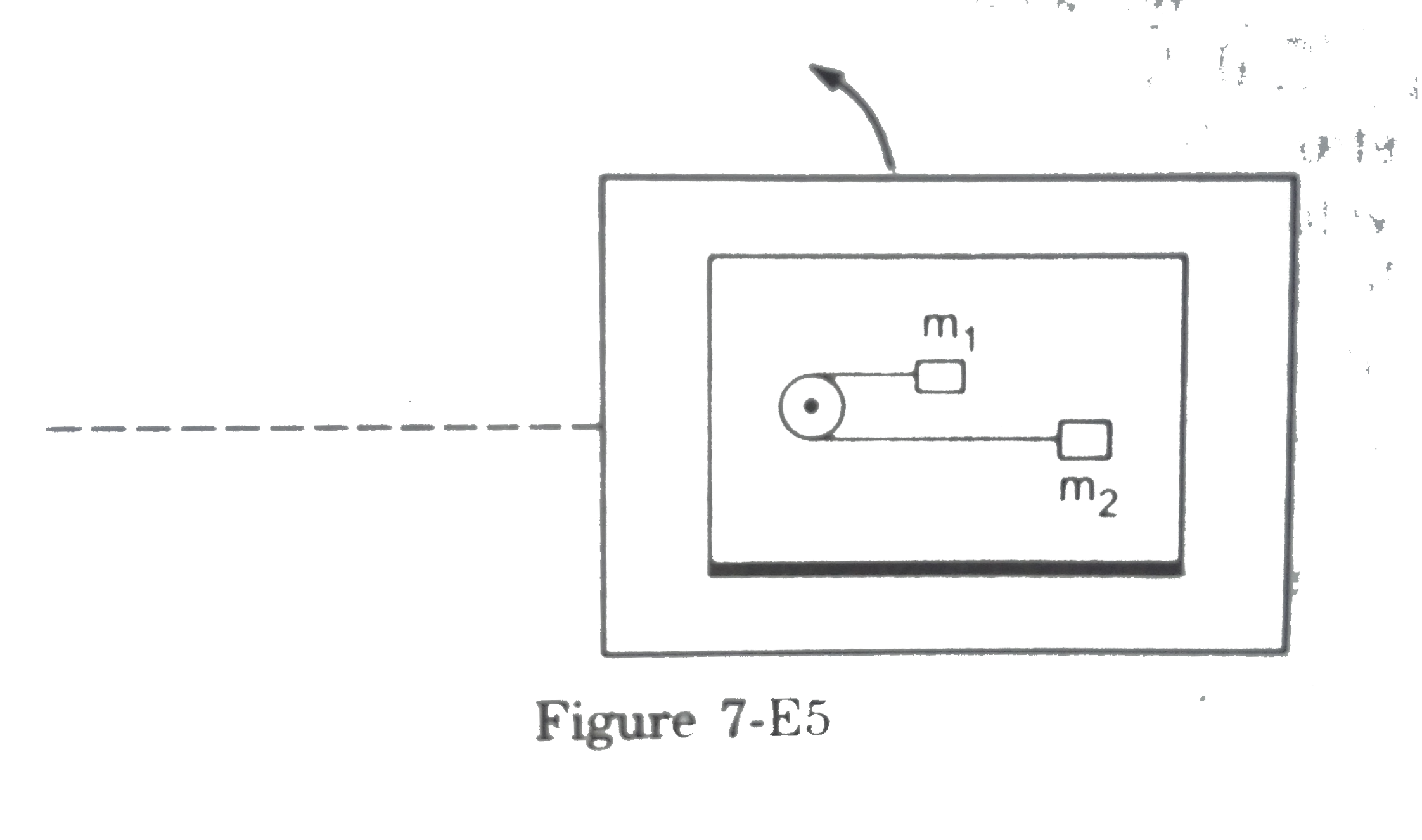
View Solution
Exercises questions and complete solutions for chapter CIRCULAR MOTION of HC VERMA PHYSICS (ENGLISH) of Class 11